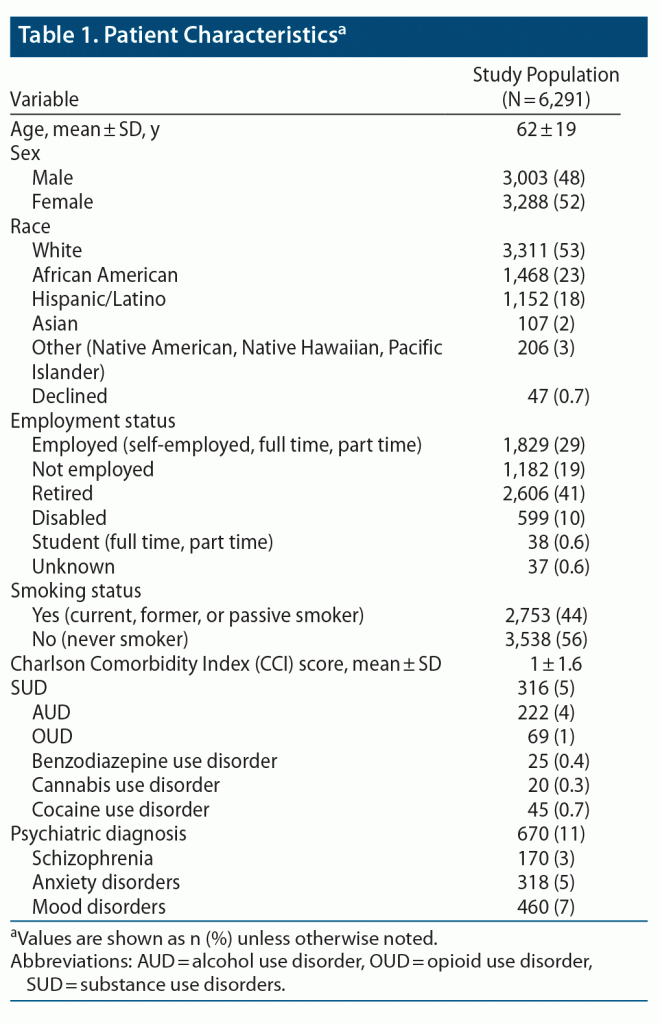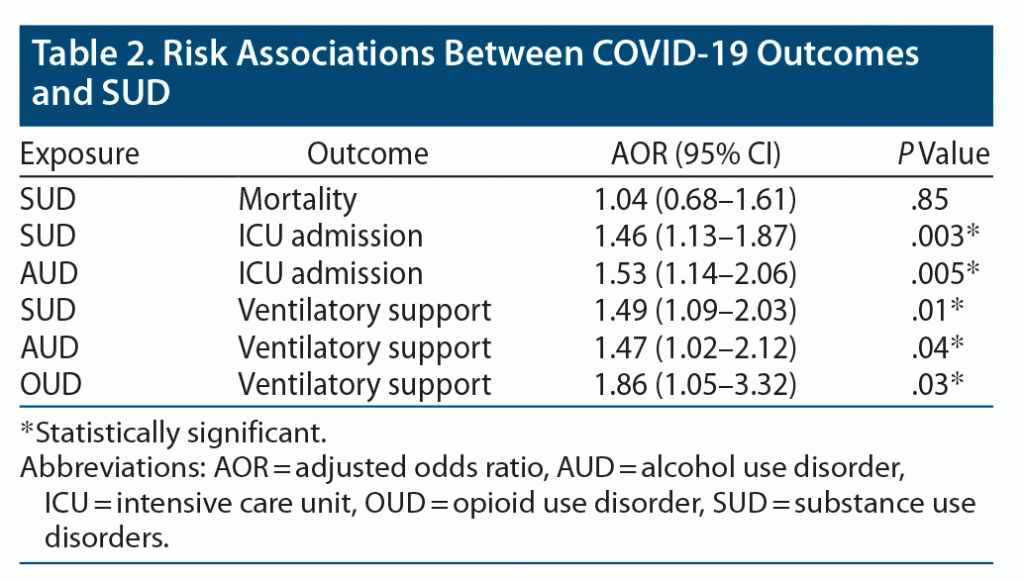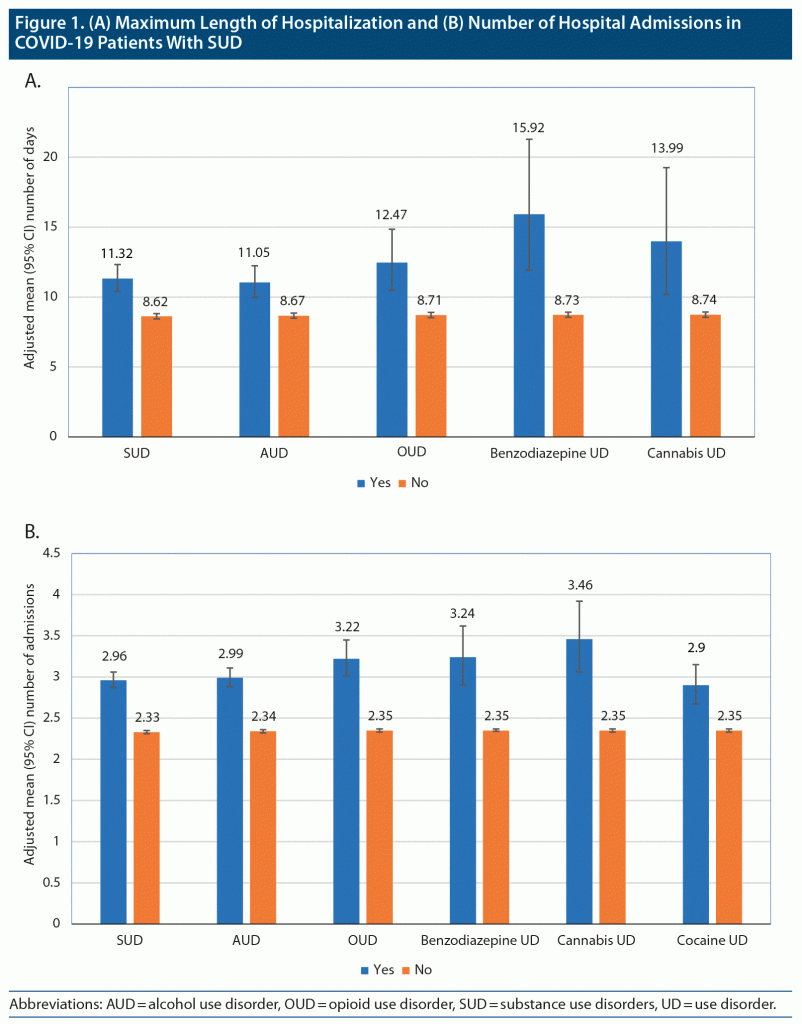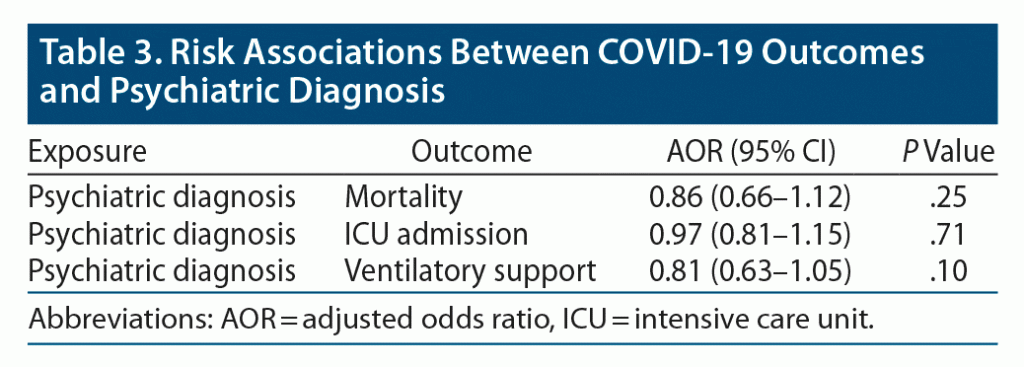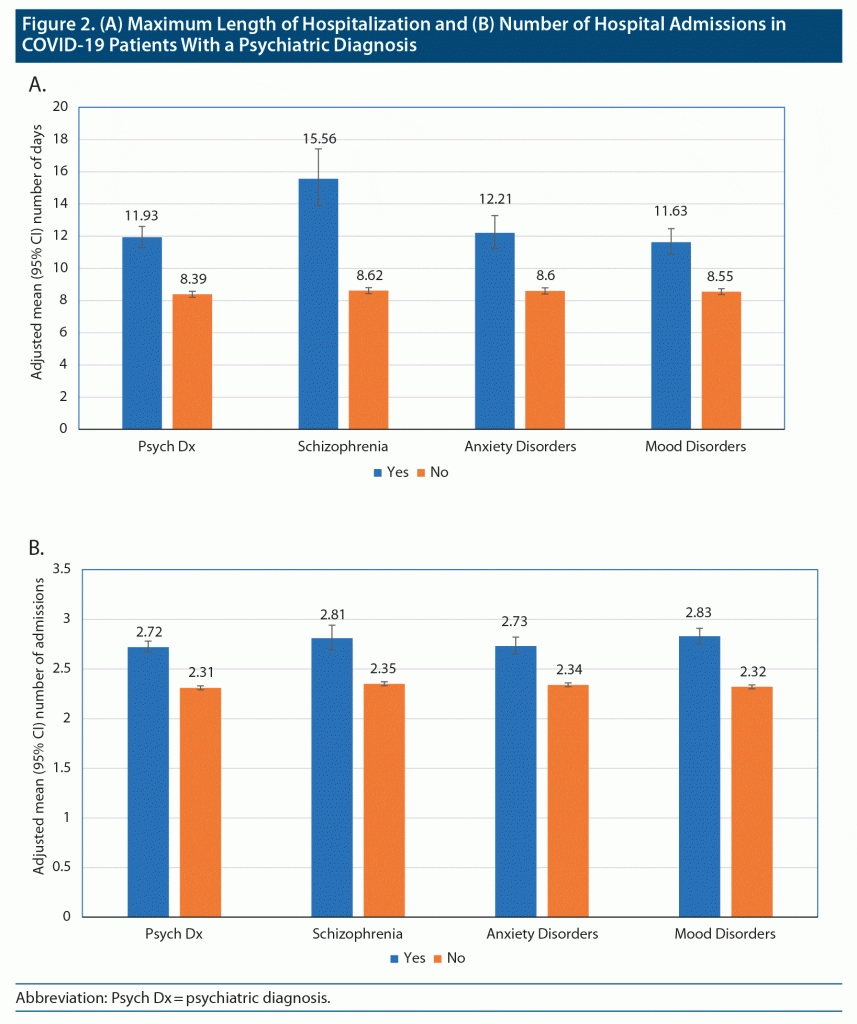ABSTRACT
Objective: While psychiatric disorders have been recognized as a risk factor for COVID-19 outcomes, the impact of substance use disorders (SUD) on COVID-19 outcomes has not, to date, been examined in a systematic manner. We examined the association between SUD (cannabis, cocaine, alcohol, opioid, and benzodiazepine) as well as psychiatric diagnoses (schizophrenia, mood disorders, anxiety disorders) and COVID-19 outcomes in a large, retrospective cohort study.
Methods: COVID-19–positive patients admitted to a large health care system in the US between January and December 2020 were included in this study. SUD and psychiatric diagnoses were identified from urine toxicology reports and ICD-10 diagnosis codes in the electronic medical record, respectively. Multivariable logistic regression was performed controlling for potential confounders such as age, race, sex, smoking status, and medical comorbidities. COVID-19–relevant outcomes included mortality, need for intensive care unit (ICU) admission, need for ventilatory support, length of hospitalization, and number of hospitalizations.
Results: Among COVID-19 patients (N = 6,291), those with SUD were more likely to require ICU admission (adjusted odds ratio [AOR] = 1.46, P = .003) and ventilatory support (AOR = 1.49, P = .01). The association between SUD and ICU admission was driven by alcohol use disorder (AUD), whereas that between SUD and ventilatory support was driven by both AUD and opioid use disorder (OUD). Patients with SUD were more likely to have a longer mean maximum length of hospitalization (11.32 vs 8.62 days, P < .0001) and a greater mean number of hospital admissions in 2020 (2.96 vs 2.33, P < .0001). These associations were significant for cannabis use disorder, AUD, OUD, and benzodiazepine use disorder. The association with greater number of admissions was also significant for cocaine use disorder. Patients with psychiatric diagnoses were also more likely to have a greater maximum length of hospitalization (11.93 vs 8.39 days, P < .0001) and hospital admissions (2.72 vs 2.31, P < .0001). These associations were significant for schizophrenia, mood disorders, and anxiety disorders.
Conclusions: COVID-19 patients with SUD had greater likelihood of requiring critical interventions, such as ICU admission and ventilatory support. SUD and psychiatric diagnoses were also associated with a longer duration of hospitalization and greater number of hospital admissions. These findings identify COVID-19 patients with SUD and psychiatric comorbidities as a high-risk group.
J Clin Psychiatry 2022;83(5):21m14332
To cite: Ramakrishnan D, Sureshanand S, Pittman B, et al. Impact of cannabis use, substance use disorders, and psychiatric diagnoses on COVID-19 outcomes: a retrospective cohort study. J Clin Psychiatry. 2022;83(5):21m14332.
To share: https://doi.org/10.4088/JCP.21m14332
© 2022 Physicians Postgraduate Press, Inc.
aYale University School of Medicine, New Haven, Connecticut
bYale Center for Clinical Investigations, Joint Data Analytics Team, New Haven, Connecticut
cDepartment of Psychiatry, Yale University School of Medicine, New Haven, Connecticut
*Corresponding author: Rajiv Radhakrishnan, MBBS, MD, 300 George St, Ste 901, New Haven, CT 06511 ([email protected]).
Find more articles on this and other psychiatry and CNS topics:
The Journal of Clinical Psychiatry
The Primary Care Companion for CNS Disorders
CME Background
Articles are selected for credit designation based on an assessment of the educational needs of CME participants, with the purpose of providing readers with a curriculum of CME articles on a variety of topics throughout each volume. Activities are planned using a process that links identified needs with desired results.
To obtain credit, read the article, correctly answer the questions in the Posttest, and complete the Evaluation.
CME Objective
After studying this article, you should be able to:
- Understand which SUDs and other psychiatric patient subgroups may be more susceptible to severe COVID-19 infections and outcomes and better direct needed medical attention to these patients.
Accreditation Statement
The CME Institute of Physicians Postgraduate Press, Inc., is accredited by the Accreditation Council for Continuing Medical Education to provide continuing medical education for physicians.
Credit Designation
The CME Institute of Physicians Postgraduate Press, Inc., designates this journal-based CME activity for a maximum of 1 AMA PRA Category 1 Credit™. Physicians should claim only the credit commensurate with the extent of their participation in the activity.
Note: The American Nurses Credentialing Center (ANCC) and the American Academy of Physician Assistants (AAPA) accept certificates of participation for educational activities certified for AMA PRA Category 1 Credit™ from organizations accredited by the ACCME.
Release, Expiration, and Review Dates
This educational activity was published in August 2022 and is eligible for AMA PRA Category 1 Credit™ through October 31, 2023. The latest review of this material was August 2022.
Financial Disclosure
All individuals in a position to influence the content of this activity were asked to complete a statement regarding all relevant personal financial relationships between themselves or their spouse/partner and any commercial interest. The CME Institute has resolved any conflicts of interest that were identified. In the past 3 years, Marlene P. Freeman, MD, Editor in Chief, has received research funding from JayMac and Sage; has been a member of the Independent Data Safety and Monitoring Committee for Janssen (Johnson & Johnson), Novartis, and Neurocrine; and has served on advisory boards for Eliem and Sage. As an employee of Massachusetts General Hospital (MGH), Dr Freeman works with the MGH National Pregnancy Registry, which receives funding from Alkermes, Aurobindo, AuroMedics, Johnson & Johnson/Janssen, Otsuka, Sage, Sunovion, Supernus, and Teva, and works with the MGH Clinical Trials Network and Institute, which receives research funding from multiple pharmaceutical companies and the National Institute of Mental Health. Dr Freeman has also received royalties through MGH for the Massachusetts General Hospital Female Reproductive Lifecycle and Hormones Questionnaire. No member of the CME Institute staff reported any relevant personal financial relationships. Faculty financial disclosure appears at the end of the article.
The coronarvirus disease 2019 (COVID-19) pandemic, caused by the SARS-CoV-2 virus, has resulted in unprecedented morbidity and mortality. As of November 2021, there have been more than 250 million cases and 5.1 million deaths worldwide, with over 47 million cases and 783,000 deaths in the United States alone.1 Despite the development of vaccines, the COVID-19 pandemic continues to overwhelm several nations due to difficulties in vaccine rollouts and the emergence of the more virulent variants, such as the delta variant.
Identifying risk factors that predispose individuals to negative COVID-19 outcomes is important to ensure that vaccine efforts and medical attention are appropriately directed, especially in resource-poor settings. The Centers for Disease Control and Prevention (CDC) has employed a risk stratification approach using age > 65 years, body mass index (BMI) > 30, and the presence of chronic lung and heart disease to guide vaccine efforts in the US. In addition, recent literature has begun to explore the association between prior psychiatric diagnoses and health outcomes in COVID-19 patients.2–9 Multiple studies have found evidence for an increased association between mortality related to COVID-19 and psychiatric disorders, including schizophrenia, bipolar disorder, and depressive disorders.7–9 There is also some evidence for increased rates of COVID-19 infection among patients with schizophrenia.4 However, there is only preliminary evidence for the association between psychiatric disorders and other COVID-19–related health outcomes, such as length of hospitalization and need for critical in-hospital interventions, such as ventilatory support or intensive care unit (ICU) admission.10
While several studies have looked at the association between psychiatric diagnoses and COVID-19 outcomes,8 the association between substance use disorders (SUD) and COVID-19 outcomes has been less systematically studied. Preliminary evidence suggests that patients with SUD, especially opioid use disorder (OUD) and alcohol use disorder (AUD), are at an increased risk of COVID-19–related mortality and hospitalization.11–13 One study14 proposed that opioid-induced respiratory depression may explain the increased risk of more severe health outcomes in COVID-19 patients with OUD. There are fewer data on the impact of SUD, such as cocaine or cannabis use disorders, on other COVID-19–related health outcomes, such as need for ICU admission or ventilatory support.
Elucidating the relationship between psychiatric disorders, SUD, and COVID-19 health outcomes is a crucial endeavor to expand the list of risk factors and to guide vaccine rollout efforts. Understanding this interaction is also essential for directing appropriate medical attention to patient populations that may be predisposed to more severe COVID-19 infections. The aim of the current study was to examine the association between SUD, psychiatric diagnosis, and COVID-19–related clinical outcomes, adjusting for demographic factors, smoking status, and medical comorbidities.
METHODS
Database Description
We conducted a retrospective cohort study of all COVID-19–positive patients admitted to the Yale New Haven Health (YNHH) system, a large health care system in New Haven, Connecticut, between January and December 2020. Data were extracted from electronic health records (ie, EPIC EHR Software, Epic Systems Corporation) with the help of the Yale Center for Clinical Investigations (YCCI) Joint Data Analytics Team (JDAT). The study was approved for exemption of review and waiver of consent by the institutional review board of Yale University. The study followed the Strengthening the Reporting of Observational Studies in Epidemiology (STROBE) reporting guideline for cohort studies.
Study Population
The cohort consisted of 6,291 COVID-19–positive patients admitted to the YNHH system from January to December 2020. The exposure variables of interest were psychiatric diagnosis (including schizophrenia, mood disorders, and anxiety disorders) and SUD (including AUD, OUD, benzodiazepine use disorder, cannabis use disorder, and cocaine use disorder). Psychiatric and substance use disorder diagnoses were identified from urine toxicology results and ICD-10 diagnosis codes in each patient’s problem list on EPIC. The outcome variables of interest determined a priori were mortality, ICU admission, length of ICU admission, need for ventilatory support, number of days on ventilatory support, number of hospital admissions from January to December 2020, and maximum length of hospitalization.
The following analyses were performed: (1) we examined whether there was an increased risk of mortality, ICU admission, and need for ventilatory support among COVID-19–positive patients with any SUD or psychiatric diagnosis; (2) we examined whether COVID-19–positive patients with any SUD or psychiatric diagnosis who required an ICU admission or ventilatory support had a longer duration of ICU admission or ventilatory support; and (3) we examined whether COVID-19–positive patients with any SUD or psychiatric diagnosis had a greater number of hospital admissions and longer maximum length of hospitalization.
Statistical Analysis
All analyses were controlled for age, sex, race, smoking status, and medical comorbidities measured by the Charlson Comorbidity Index (CCI) derived from ICD-10 diagnosis codes.15 We performed a multivariable logistic regression to calculate the adjusted odds ratio (AOR), 95% confidence interval (CI), and P value for the following categorical outcome variables: mortality, ICU admission, and need for ventilatory support. We performed a 1-way analysis of variance (ANOVA) test to determine the adjusted geometric mean, 95% CI, and P value for the following continuous outcome variables: length of ICU admission, days on ventilatory support, number of hospital admissions, and maximum length of hospitalization. All outcomes were assessed for normality prior to analysis using normal probability plots and Kolmogorov test statistics. When outcome variables were not normally distributed, log transformation was performed. All analyses were conducted using SAS, version 9.4 (SAS Institute, Inc).
RESULTS
Patient Characteristics
The total study population comprised 6,291 patients (48% male and 52% female) with a mean ± SD age of 62 ± 19 years. The rate of mortality in this cohort was 13%. The rates of ICU admission and need for ventilatory support were 28% and 12%, respectively. Among those requiring an ICU admission and ventilatory support, the mean ± SD duration was 9 ± 11 days and 11 ± 14 days, respectively. The mean ± SD maximum length of hospitalization was 11 ± 12 days, and the mean ± SD number of hospital admissions was 1 ± 1. Further details of the study demographics are listed in Table 1.
Associations Between COVID-19 Outcomes and SUD
Mortality among COVID-19 patients with any SUD was not significantly different from that among those without SUD (AOR = 1.04 [95% CI, 0.68–1.61], P = .85). However, COVID-19 patients with any SUD had a greater risk of requiring an ICU admission (AOR = 1.46 [95% CI, 1.13–1.87], P = .003) and ventilatory support (AOR = 1.49 [95% CI, 1.09–2.03] P = .01) during hospitalization than those without SUD. Among patients with any SUD, only those with AUD had a significantly greater risk of requiring ICU admission (AOR = 1.53 [95% CI, 1.14–2.06], P = .005), while there was a significantly greater risk of requiring ventilatory support among both AUD (AOR = 1.47 [95% CI, 1.02–2.12], P = .04) and OUD (AOR = 1.86 [95% CI, 1.05–3.32], P = .03) patients (Table 2). Although COVID-19 patients with any SUD were more likely to require an ICU admission and ventilatory support, among those requiring these interventions, there was no significant association between SUD and either length of ICU admission (P = .74) or days on ventilatory support (P = .82).
However, COVID-19 patients with SUD had a significantly longer mean (95% CI) maximum length of hospitalization than those without SUD when adjusted for age, sex, race, smoking status, and CCI score (11.32 [10.40–12.33] vs 8.62 [8.44–8.81] days, P < .0001). Among those with SUD, there was a significant association between maximum length of hospitalization and the following subcategories of SUD: AUD (11.05 [9.98–12.24] vs 8.67 [8.49–8.86] days, P < .0001), OUD (12.47 [10.47–14.85] vs 8.71 [8.53–8.90] days, P < .0001), benzodiazepine use disorder (15.92 [11.91–21.28] vs 8.73 [8.55–8.92] days, P < .0001), and cannabis use disorder (13.99 [10.18–19.25] vs 8.74 [8.55–8.93] days, P = .004) (Figure 1A). COVID-19 patients with SUD also had significantly more mean (95% CI) hospital admissions in 2020 than those without SUD after adjustment for age, sex, race, smoking status, and CCI score (2.96 [2.87–3.06] vs 2.33 [2.31–2.35], P < .0001). This association was significant for the following SUD subcategories: AUD (2.99 [2.88–3.11] vs 2.34 [2.32–2.36], P < .0001), OUD (3.22 [3.01–3.45] vs 2.35 [2.33–2.37], P < .0001), benzodiazepine use disorder (3.24 [2.90–3.62] vs 2.35 [2.34–2.37], P < .0001), cannabis use disorder (3.46 [3.06–3.92] vs 2.35 [2.33–2.37], P < .0001), and cocaine use disorder (2.90 [2.67–3.15] vs 2.35 [2.33–2.37], P < .0001) (Figure 1B).
Associations Between COVID-19 Outcomes and Psychiatric Diagnosis
There was no significant difference in the risk of mortality (AOR = 0.86 [95% CI, 0.66–1.12], P = .25), ICU admission (AOR = 0.97 [95% CI, 0.81–1.15], P = .71), and ventilatory support (AOR = 0.81 [95% CI, 0.63–1.05], P = .10) between COVID-19 patients with any psychiatric diagnosis (schizophrenia, mood disorders, or anxiety disorders) and those without a psychiatric diagnosis (Table 3). Among patients who required an ICU admission or ventilatory support, the length of ICU admission (P = .32) and days on ventilatory support (P = .25) were not significantly different between those with a psychiatric diagnosis and those without one.
However, after adjustment for age, sex, race, smoking status, and CCI score, COVID-19 patients with any psychiatric diagnosis had a significantly longer mean (95% CI) maximum length of hospitalization than those without a psychiatric diagnosis (11.93 [11.29–12.60] vs 8.39 [8.20–8.58] days, P < .0001). Among patients with a psychiatric diagnosis, those with schizophrenia (15.56 [13.90–17.42] vs 8.62 [8.43–8.80] days, P < .0001), anxiety disorders (12.21 [11.23–13.28] vs 8.60 [8.41–8.79] days, P < .0001), and mood disorders (11.63 [10.85–12.47] vs 8.55 [8.37–8.74] days, P < .0001) had a significantly longer maximum length of hospitalization (Figure 2A). COVID-19 patients with a psychiatric diagnosis also had a greater mean (95% CI) number of hospital admissions in 2020 than those without a psychiatric diagnosis when adjusted for age, sex, race, smoking status, and CCI score (2.72 [2.67–2.78] vs 2.31 [2.29–2.33], P < .0001). This association was significant for those with schizophrenia (2.81 [2.69–2.94] vs 2.35 [2.33–2.37], P < .0001), anxiety disorders (2.73 [2.65–2.82] vs 2.34 [2.32–2.36], P < .0001), and mood disorders (2.83 [2.75–2.91] vs 2.32 [2.30–2.34], P < .0001) (Figure 2B).
DISCUSSION
In this retrospective cohort study, we examined the association between SUD, psychiatric diagnosis, and health outcomes in a cohort of COVID-19–positive patients using electronic health record data while adjusting for potential confounders, including medical comorbidity. We found that patients with any SUD were at greater risk of requiring critical interventions, including ICU admission and ventilatory support. The strength of the association was greatest for patients with OUD and AUD. However, patients with any SUD did not have a significantly longer duration of ICU admission or ventilatory support. Unlike patients with any SUD, those with any psychiatric diagnosis were not at greater risk of requiring ICU admission or ventilatory support. We also found that patients with any SUD or any psychiatric diagnosis had a significantly longer maximum length of hospitalization and number of hospital admissions. These associations were significant for most or all of the subcategories of SUD, including OUD, AUD, benzodiazepine use disorder, cocaine use disorder, and cannabis use disorder. The associations were also significant for all subcategories of psychiatric disorders, including schizophrenia, mood disorders, and anxiety disorders. Surprisingly, neither psychiatric diagnosis nor SUD was associated with a greater risk of mortality in COVID-19–positive patients after adjustment for medical comorbidities.
Although one observational study with a small sample size16 suggests a low incidence of severe COVID-19 infections in patients with SUD, our study results are consistent with most studies in the literature that have shown an increased risk of adverse COVID-19 outcomes,17,18 including ventilator use,12 ICU admission,11 and hospitalization11 in COVID-19 patients with SUD. We also found that among the categories of SUD, OUD and AUD were significantly associated with a greater risk of requiring critical interventions, such as ICU admission and ventilatory support. This result is consistent with a previous study in the literature that showed that OUD and AUD were associated with the worst COVID-19 outcomes among the subcategories of SUD.13 The association between OUD and increased risk of ventilatory support may be due to opioid-induced respiratory depression that has been suggested as a plausible biological mechanism for the increased risk of hypoxemia in COVID-19 patients with OUD.14 Another analysis found that among COVID-19–positive patients, those with AUD and cocaine use disorder were associated with increased risk of hospitalization.11 Similarly, our results suggest an increased risk of negative COVID-19 outcomes, specifically increased hospital admissions and longer duration of hospitalization, in patients with prior psychiatric diagnoses, such as schizophrenia, mood disorders, and anxiety disorders. These results are consistent with several other studies that have found an increased risk of adverse health outcomes in patients with prior psychiatric diagnoses, especially schizophrenia, bipolar disorder, and other mood disorders.5,9,19,20 Notably, our results suggest that even patients with an anxiety disorder had longer lengths of hospitalization and more hospital admissions, an association that was not found in other studies.7,19
Unlike other studies in the literature,3,4,12,13,21,22 our study did not find an increased risk of mortality in patients with either a psychiatric diagnosis or any SUD when adjusting for demographic variables and medical comorbidities. There may be many reasons for this finding, albeit speculative. First, it is possible that prior reports of increased mortality in patients with schizophrenia have sensitized the health system to the fact that this population is at high risk, and thus resulted in more intensive care for these patients. This possibility may explain the finding of longer duration of hospitalization and greater number of hospitalizations in this population in our dataset. Secondly, it is possible that the finding of increased mortality in patients with psychiatric diagnosis and SUD is mediated by increased medical comorbidity. Since we used CCI score as a covariate in our analysis, we were unable to detect group differences.
The main limitation of our study is that we focused on all-cause mortality and not COVID-19–specific mortality during the year of 2020. Our findings did not show an association between either psychiatric diagnosis or SUD and mortality in COVID-19 patients admitted to YNHH in 2020. However, this does not necessarily preclude the possibility that patients with a psychiatric diagnosis or SUD had an increased risk of mortality specifically attributable to COVID-19–related complications. Another limitation of our study was that we included all patients who tested positive for COVID-19 during one of their admissions to YNHH. It is possible that some of these patients were asymptomatic during their time of admission and were in the hospital for health concerns unrelated to COVID-19. This possibility limits our ability to make a direct conclusion about an association between patients with active COVID-19 infection and either psychiatric diagnosis or SUD. Furthermore, patients admitted to YNHH mainly come from the Greater New Haven area, a demographic that has a higher percentage of people who identify as African American (33.6% vs 13.4%) or Latino (30.8% vs 18.5%) than the average US population as well as a higher percentage of people in poverty defined by the US Census Bureau (25.2% vs 11.4%).23 Thus, the generalizability of our study results to other subpopulations in the US may be limited.
However, one major strength of our study is that we controlled for medical comorbidities in a systematic way using the CCI, which has become a well-established way of objectively controlling for the effect of medical comorbidities in patients.15 In addition, unlike previous studies, we controlled for the smoking status of patients, which minimizes a large confounding factor when studying COVID-19 outcomes.
While our study results show a significant association between SUD and psychiatric diagnoses and COVID-19 outcomes, it is important to note that these results came from a 2020 patient population, before the introduction of COVID-19 vaccines. Recent studies suggest that vaccine hesitancy may be greater among people with psychiatric diagnoses and SUD.24–26 One study24 reveals a higher prevalence of vaccine hesitancy across several psychiatric diagnoses, including major depressive disorder, bipolar disorder, generalized anxiety disorder, attention-deficit/hyperactivity disorder, and SUD. Those with SUD and nicotine use disorder/tobacco dependence had a higher prevalence of vaccine hesitancy after adjusting for potential sociodemographic confounders. Future studies should focus on assessing the effect of vaccination status on the association between SUD and psychiatric diagnoses with COVID-19 outcomes, especially as vaccination efforts across the nation ramp up. Another question that remains unanswered is whether neuropsychiatric symptoms are causally linked to COVID-19 infection and whether these symptoms persist—ie, the so-called “long COVID syndrome” or “post–COVID-19 syndrome”27—or whether SUD and psychiatric comorbidity are risk factors for the syndrome. Longitudinal studies with detailed phenotyping will be required to answer these questions.
In summary, our retrospective cohort study found that COVID-19 patients admitted to YNHH from January to December 2020 had an increased length of hospitalization and number of hospital admissions if they had comorbid psychiatric diagnoses, such as schizophrenia, mood disorders, or anxiety disorders, or any SUD when controlling for age, sex, race, smoking status, and medical comorbidities using the CCI score. We also showed that patients with SUD were more likely to require critical interventions, such as ICU admission and ventilatory support. Together, these findings suggest that patients with comorbid psychiatric diagnoses and SUD are more at risk of developing serious complications of COVID-19 infections and are also more likely to have prolonged hospitalizations. Thus, it is important that we make more of an effort to identify these patients early on in their COVID-19 course to avoid more serious complications. Our findings suggest that perhaps COVID-19 patients with comorbid psychiatric diagnoses and SUD may be falling through the cracks in terms of medical management when earlier interventions might have prevented them from having worse health outcomes. As the COVID-19 vaccination efforts ramp up, it would be prudent to prioritize those patients with psychiatric diagnoses and SUD, who may otherwise be susceptible to prolonged and more severe courses of COVID-19 infection.28 Our findings are hence relevant to psychiatrists in enabling them to advocate for patients with psychiatric disorders and SUD and to help them navigate a complex health system to obtain vaccination and early treatment. The findings also have significance for public health policy makers. Of note, “medical cannabis” dispensaries were allowed to stay open as “essential businesses” during the COVID-19 pandemic.29 Our results raise concern regarding this policy since those with comorbid cannabis use disorder were more likely to have higher number of hospitalizations and longer duration of hospitalizations.
Submitted: November 9, 2021; accepted June 9, 2022.
Published online: August 29, 2022.
Disclosure of off-label usage: The authors have determined that, to the best of their knowledge, no investigational information about pharmaceutical agents or device therapies that is outside US Food and Drug Administration–approved labeling has been presented in this activity.
Relevant financial relationships: Dr Radhakrishnan is supported by the Dana Foundation David Mahoney program and CTSA Grant Number UL1 TR001863 from the National Center for Advancing Translational Science (NCATS), components of the National Institutes of Health (NIH), and NIH roadmap for Medical Research. He has received research support from Neurocrine Biosciences and GW Pharmaceuticals. Ms Ramakrishnan, Ms Sureshanand, and Mr Pittman have no personal affiliations or financial relationships with any commercial interest to disclose relative to the article.
Funding/support: There was no specific funding for this study.
Disclaimer: The contents of this publication are solely the responsibility of the authors and do not necessarily represent the official view of NIH or any federal agency.
Previous presentation: Poster presented at the American Society of Clinical Psychopharmacology (ASCP) Annual Meeting; October 27–29, 2021.
Clinical Points
- COVID-19 patients with substance use disorders (SUD) have greater likelihood of requiring critical interventions, such as intensive care unit admission and ventilatory support.
- Comorbid SUD and psychiatric diagnoses were associated with a longer duration of hospitalization and greater number of hospital admissions. Hence, COVID-19 patients with comorbid SUD and psychiatric diagnoses should be considered a high-risk group.
References (29)

- Centers for Disease Control and Prevention. COVID Data Tracker. CDC website. https://covid.cdc.gov/covid-data-tracker/#datatracker-home. Accessed August 9, 2022.
- Egede C, Dawson AZ, Walker RJ, et al. Relationship between mental health diagnoses and COVID-19 test positivity, hospitalization, and mortality in Southeast Wisconsin. Psychol Med. 2021:1–9. PubMed CrossRef
- Fond G, Nemani K, Etchecopar-Etchart D, et al. Association between mental health disorders and mortality among patients with COVID-19 in 7 countries: a systematic review and meta-analysis. JAMA Psychiatry. 2021;78(11):1208–1217. PubMed CrossRef
- Jeon HL, Kwon JS, Park SH, et al. Association of mental disorders with SARS-CoV-2 infection and severe health outcomes: nationwide cohort study. Br J Psychiatry. 2021;218(6):344–351. PubMed CrossRef
- Lee SW, Yang JM, Moon SY, et al. Association between mental illness and COVID-19 susceptibility and clinical outcomes in South Korea: a nationwide cohort study. Lancet Psychiatry. 2020;7(12):1025–1031. PubMed CrossRef
- Li L, Li F, Fortunati F, et al. Association of a prior psychiatric diagnosis with mortality among hospitalized patients with coronavirus disease 2019 (COVID-19) infection. JAMA Netw Open. 2020;3(9):e2023282. PubMed CrossRef
- Nemani K, Li C, Olfson M, et al. Association of psychiatric disorders with mortality among patients with COVID-19. JAMA Psychiatry. 2021;78(4):380–386. PubMed CrossRef
- Vai B, Mazza MG, Delli Colli C, et al. Mental disorders and risk of COVID-19-related mortality, hospitalisation, and intensive care unit admission: a systematic review and meta-analysis. Lancet Psychiatry. 2021;8(9):797–812. PubMed CrossRef
- Wang Q, Xu R, Volkow ND. Increased risk of COVID-19 infection and mortality in people with mental disorders: analysis from electronic health records in the United States. World Psychiatry. 2021;20(1):124–130. PubMed CrossRef
- Fond G, Pauly V, Leone M, et al. Disparities in intensive care unit admission and mortality among patients with schizophrenia and COVID-19: a national cohort study. Schizophr Bull. 2021;47(3):624–634. PubMed CrossRef
- Allen B, El Shahawy O, Rogers ES, et al. Association of substance use disorders and drug overdose with adverse COVID-19 outcomes in New York City: January–October 2020. J Public Health (Oxf). 2020;43(3):462–465. PubMed
- Baillargeon J, Polychronopoulou E, Kuo YF, et al. The impact of substance use disorder on COVID-19 outcomes. Psychiatr Serv. 2021;72(5):578–581. PubMed CrossRef
- Wang QQ, Kaelber DC, Xu R, et al. COVID-19 risk and outcomes in patients with substance use disorders: analyses from electronic health records in the United States. Mol Psychiatry. 2021;26(1):30–39. PubMed CrossRef
- Schimmel J, Manini AF. Opioid use disorder and COVID-19: biological plausibility for worsened outcomes. Subst Use Misuse. 2020;55(11):1900–1901. PubMed CrossRef
- King JT Jr, Yoon JS, Rentsch CT, et al. Development and validation of a 30-day mortality index based on pre-existing medical administrative data from 13,323 COVID-19 patients: the Veterans Health Administration COVID-19 (VACO) Index. PLoS One. 2020;15(11):e0241825. PubMed CrossRef
- Vallecillo G, Perelló R, Güerri R, et al. Clinical impact of COVID-19 on people with substance use disorders. J Public Health (Oxf). 2021;43(1):9–12. PubMed CrossRef
- Melamed OC, Hauck TS, Buckley L, et al. COVID-19 and persons with substance use disorders: inequities and mitigation strategies. Subst Abus. 2020;41(3):286–291. PubMed CrossRef
- Dubey MJ, Ghosh R, Chatterjee S, et al. COVID-19 and addiction. Diabetes Metab Syndr. 2020;14(5):817–823. PubMed CrossRef
- Barcella CA, Polcwiartek C, Mohr GH, et al. Severe mental illness is associated with increased mortality and severe course of COVID-19. Acta Psychiatr Scand. 2021;144(1):82–91. PubMed CrossRef
- Castro VM, Gunning FM, McCoy TH, et al. Mood disorders and outcomes of COVID-19 hospitalizations. Am J Psychiatry. 2021;178(6):541–547. PubMed CrossRef
- Diez-Quevedo C, Iglesias-González M, Giralt-López M, et al. Mental disorders, psychopharmacological treatments, and mortality in 2150 COVID-19 Spanish inpatients. Acta Psychiatr Scand. 2021;143(6):526–534. PubMed CrossRef
- Fond G, Pauly V, Orleans V, et al. Increased in-hospital mortality from COVID-19 in patients with schizophrenia. Encephale. 2021;47(2):89–95. PubMed CrossRef
- US Census Bureau. Population Estimates Program (PEP). US Census Bureau website. https://www.census.gov/quickfacts/fact/table/newhavencityconnecticut/PST045221#PST045221. 2020.
- Eyllon M, Dang AP, Barnes JB, et al. Associations between psychiatric morbidity and COVID-19 vaccine hesitancy: an analysis of electronic health records and patient survey. Psychiatry Res. 2022;307:114329. PubMed CrossRef
- Uvais NA. COVID-19 vaccine hesitancy among patients with psychiatric disorders. Prim Care Companion CNS Disord. 2021;23(6):21br03028. PubMed CrossRef
- Jefsen OH, Kølbæk P, Gil Y, et al. COVID-19 vaccine willingness amongst patients with mental illness compared with the general population. Acta Neuropsychiatr. 2021;33(5):273–276. PubMed CrossRef
- Efstathiou V, Stefanou MI, Demetriou M, et al. Long COVID and neuropsychiatric manifestations (review). Exp Ther Med. 2022;23(5):363. PubMed CrossRef
- Yang Y, Li W, Zhang Q, et al. Should people with severe mental illness be prioritized for the COVID-19 vaccination? Int J Biol Sci. 2021;17(6):1443–1445. PubMed CrossRef
- Opp SM, Mosier SL. Liquor, marijuana, and guns: essential services or political tools during the Covid-19 pandemic? Policy Design and Practice. 2020;3(3):297–311. CrossRef
This PDF is free for all visitors!
Save
Cite
